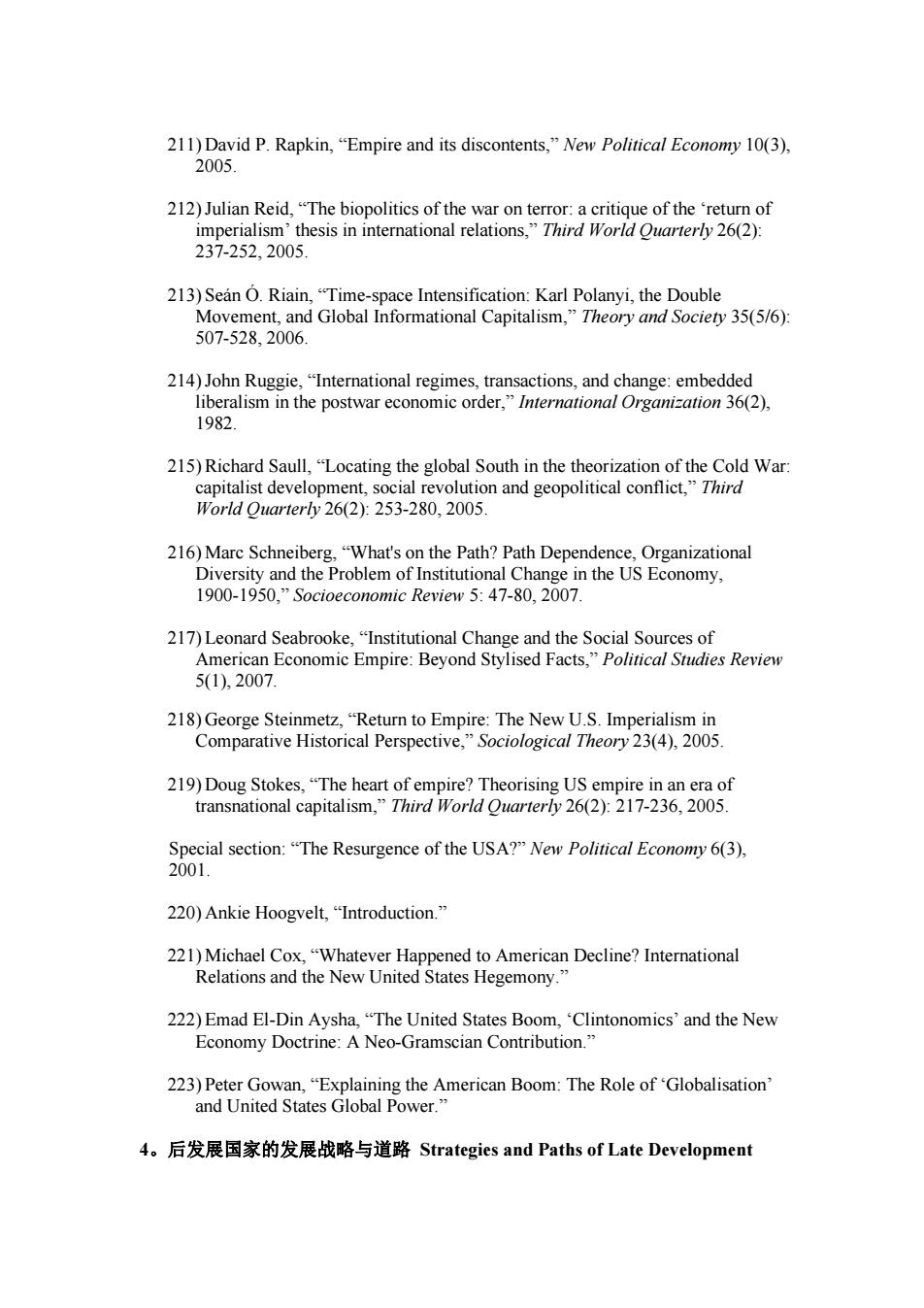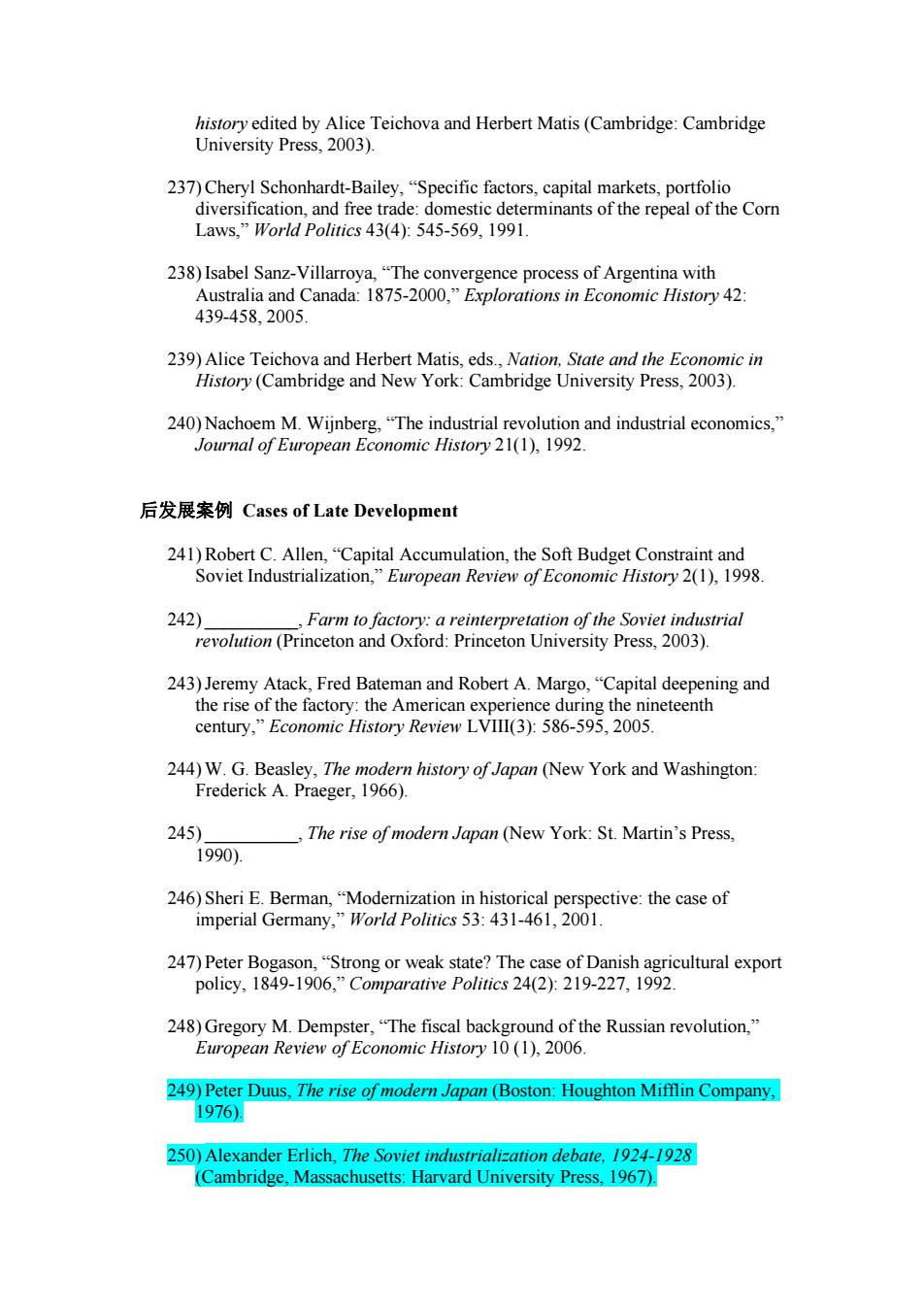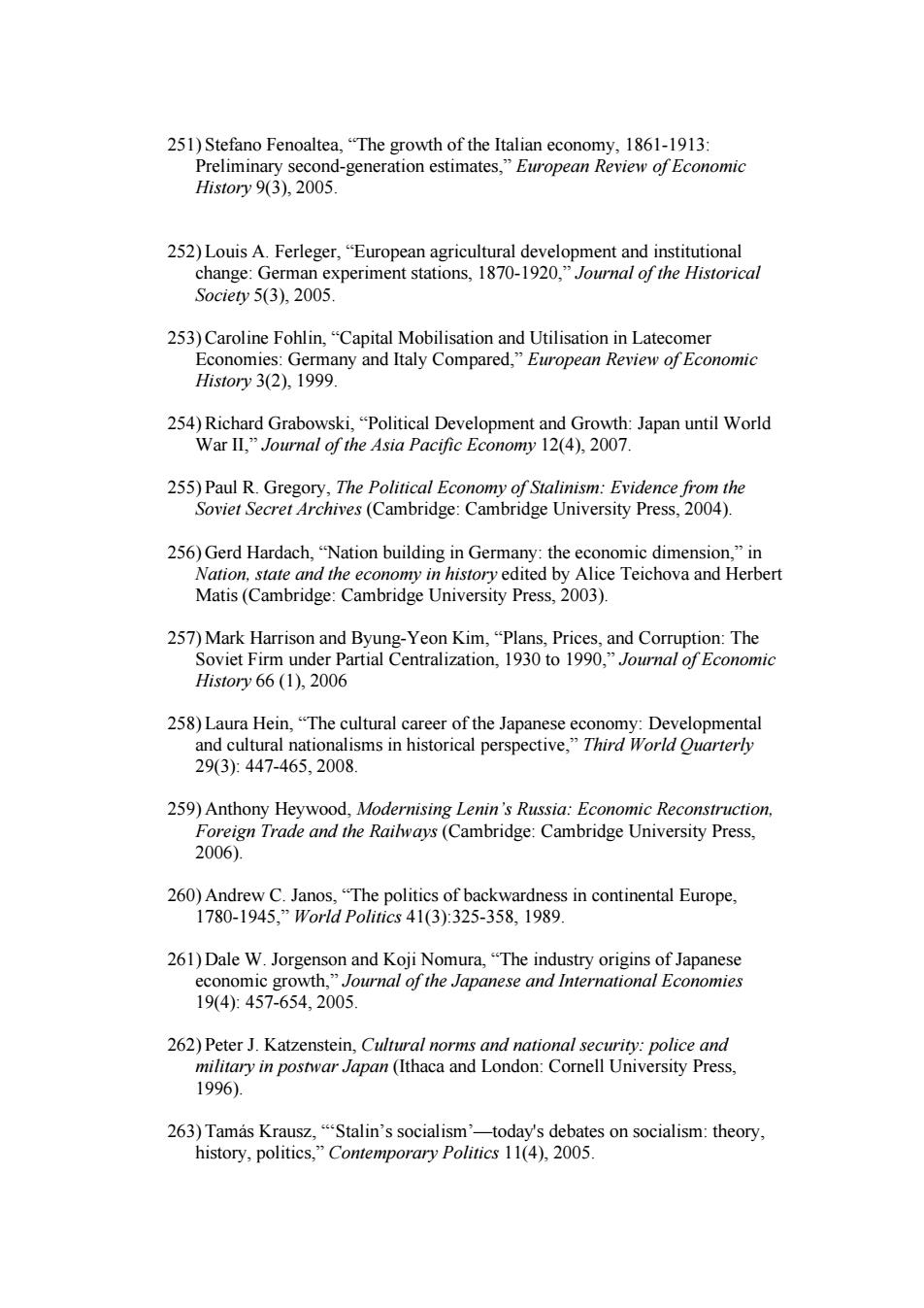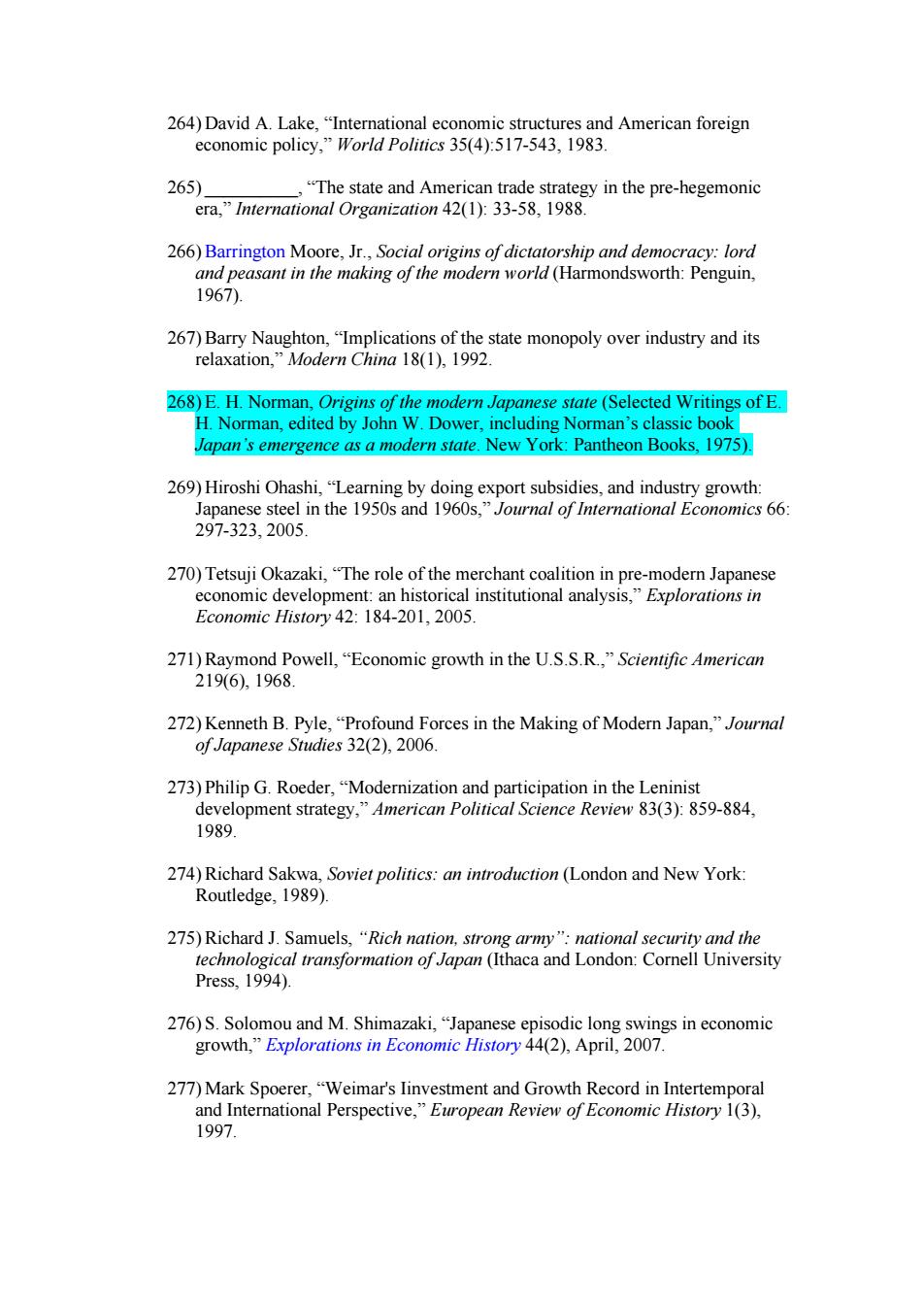
211)David P.Rapkin,"Empire and its discontents,"New Political Economy 10(3), 2005. 212)Julian Reid,"The biopolitics of the war on terror:a critique of the return of imperialism'thesis in international relations,"Third World Ouarterly 26(2): 237-252,2005. 213)Sean O.Riain,"Time-space Intensification:Karl Polanyi,the Double Movement,and Global Informational Capitalism,"Theory and Society 35(5/6): 507-528,2006. 214)John Ruggie,"International regimes,transactions,and change:embedded liberalism in the postwar economic order,"International Organization 36(2), 1982 215)Richard Saull,"Locating the global South in the theorization of the Cold War: capitalist development,social revolution and geopolitical conflict,"Third World Quarterly 26(2):253-280,2005 216)Marc Schneiberg,"What's on the Path?Path Dependence,Organizational Diversity and the Problem of Institutional Change in the US Economy, 1900-1950,"Socioeconomic Review 5:47-80,2007. 217)Leonard Seabrooke,"Institutional Change and the Social Sources of American Economic Empire:Beyond Stylised Facts,"Political Studies Review 5(1),2007. 218)George Steinmetz,"Return to Empire:The New U.S.Imperialism in Comparative Historical Perspective,"Sociological Theory 23(4),2005. 219)Doug Stokes,"The heart of empire?Theorising US empire in an era of transnational capitalism,"Third World Ouarterly 26(2):217-236,2005. Special section:"The Resurgence of the USA?"New Political Economy 6(3), 2001. 220)Ankie Hoogvelt,“Introduction.” 221)Michael Cox,"Whatever Happened to American Decline?International Relations and the New United States Hegemony." 222)Emad El-Din Aysha,"The United States Boom,Clintonomics'and the New Economy Doctrine:A Neo-Gramscian Contribution." 223)Peter Gowan,"Explaining the American Boom:The Role of'Globalisation' and United States Global Power." 4。后发展国家的发展战略与道路Strategies and Paths of Late Development
211) David P. Rapkin, “Empire and its discontents,” New Political Economy 10(3), 2005. 212)Julian Reid, “The biopolitics of the war on terror: a critique of the ‘return of imperialism’ thesis in international relations,” Third World Quarterly 26(2): 237-252, 2005. 213) Seán Ó. Riain, “Time-space Intensification: Karl Polanyi, the Double Movement, and Global Informational Capitalism,” Theory and Society 35(5/6): 507-528, 2006. 214)John Ruggie, “International regimes, transactions, and change: embedded liberalism in the postwar economic order,” International Organization 36(2), 1982. 215) Richard Saull, “Locating the global South in the theorization of the Cold War: capitalist development, social revolution and geopolitical conflict,” Third World Quarterly 26(2): 253-280, 2005. 216) Marc Schneiberg, “What's on the Path? Path Dependence, Organizational Diversity and the Problem of Institutional Change in the US Economy, 1900-1950,” Socioeconomic Review 5: 47-80, 2007. 217) Leonard Seabrooke, “Institutional Change and the Social Sources of American Economic Empire: Beyond Stylised Facts,” Political Studies Review 5(1), 2007. 218) George Steinmetz, “Return to Empire: The New U.S. Imperialism in Comparative Historical Perspective,” Sociological Theory 23(4), 2005. 219) Doug Stokes, “The heart of empire? Theorising US empire in an era of transnational capitalism,” Third World Quarterly 26(2): 217-236, 2005. Special section: “The Resurgence of the USA?” New Political Economy 6(3), 2001. 220) Ankie Hoogvelt, “Introduction.” 221) Michael Cox, “Whatever Happened to American Decline? International Relations and the New United States Hegemony.” 222) Emad El-Din Aysha, “The United States Boom, ‘Clintonomics’ and the New Economy Doctrine: A Neo-Gramscian Contribution.” 223) Peter Gowan, “Explaining the American Boom: The Role of ‘Globalisation’ and United States Global Power.” 4。后发展国家的发展战略与道路 Strategies and Paths of Late Development

后发展概述Introduction to Late Development 224)夏诚著,《世界现代化史纲(第一卷):世界体系的形成与第一轮现代 化》(南宁:广西人民出版社,1999年)。 225)Daron Acemoglu and James A.Robinson,"Economic Backwardness in Political Perspective,"American Political Science Review 100(1),2006. 226)Ha-Joon Chang,Kicking away the ladder:development strategy in historical perspective (London:Anthem Press,2002). 227) ,"Policy space in historical perspective-with special reference to trade and industrial policies,"A paper presented at the Queen Elizabeth House 50th Anniversary Conference,Queen Elizabeth House,University of Oxford,July 2005. 228) Bad Samaritans:The Myth of Free Trade and the Secret History ofCapitalism (New York:Bloomsbury Press,2008) 229)Bradford,Colin,Jr."Policy interventions and markets:development strategy typologies and policy options",in Manufacturing miracles:paths of industrialization in Latin America and East Asia edited by Gary Gereffi and Donald L.Wyman(Princeton:Princeton University Press,1990). 230)Karl W.Deutsch and Alexander Eckstein,"National industrialization and the declining share of the international economic sector,1890-1959,"World Politics13(2):267-299,1961. 231)Ann Firth,"State form,social order and the social sciences:urban space and politico-economic systems 1760-1850,"Journal of Historical Sociology 16(1), 2003. 232)Gary Gereffi,"Paths of industrialization:an overview",in Manufacturing miracles:paths of industrialization in Latin America and East Asia edited by Gary Gereffi and Donald L.Wyman(Princeton:Princeton University Press, 1990),pp.8-23 233)Alexander Gerschenkron,Economic backwardness in historical perspective: a book ofessays (Cambridge (Mass.):Harvard University Press,1962). 234)James R.Kurth,"The political consequences of the product cycle:industrial history and political outcomes,"International Organization 33(1),1979 235)Thomas Leng,"Commercial Conflict and Regulation in the Discourse of Trade in Seventeenth-Century England,"The Historical Journal 48(4),2005. 236)Patrick K.O'Brien,"Political structures and grand strategies for the growth of the British economy,1688-1815,"in Nation,state and the economy in
后发展概述 Introduction to Late Development 224) 夏诚 著,《世界现代化史纲(第一卷):世界体系的形成与第一轮现代 化》(南宁:广西人民出版社,1999 年)。 225) Daron Acemoglu and James A. Robinson, “Economic Backwardness in Political Perspective,” American Political Science Review 100(1), 2006. 226) Ha-Joon Chang, Kicking away the ladder: development strategy in historical perspective (London: Anthem Press, 2002). 227) __________, “Policy space in historical perspective – with special reference to trade and industrial policies,” A paper presented at the Queen Elizabeth House 50 th Anniversary Conference, Queen Elizabeth House, University of Oxford, July 2005. 228) __________, Bad Samaritans: The Myth of Free Trade and the Secret History of Capitalism (New York: Bloomsbury Press, 2008). 229) Bradford, Colin, Jr. “Policy interventions and markets: development strategy typologies and policy options”, in Manufacturing miracles: paths of industrialization in Latin America and East Asia edited by Gary Gereffi and Donald L. Wyman (Princeton: Princeton University Press, 1990). 230) Karl W. Deutsch and Alexander Eckstein, “National industrialization and the declining share of the international economic sector, 1890-1959,” World Politics 13(2): 267-299, 1961. 231) Ann Firth, “State form, social order and the social sciences: urban space and politico-economic systems 1760-1850,” Journal of Historical Sociology 16(1), 2003. 232) Gary Gereffi, “Paths of industrialization: an overview”, in Manufacturing miracles: paths of industrialization in Latin America and East Asia edited by Gary Gereffi and Donald L. Wyman (Princeton: Princeton University Press, 1990), pp.8-23. 233) Alexander Gerschenkron, Economic backwardness in historical perspective: a book of essays (Cambridge (Mass.): Harvard University Press, 1962). 234)James R. Kurth, “The political consequences of the product cycle: industrial history and political outcomes,” International Organization 33(1), 1979. 235) Thomas Leng, “Commercial Conflict and Regulation in the Discourse of Trade in Seventeenth-Century England,” The Historical Journal 48(4), 2005. 236) Patrick K. O’Brien, “Political structures and grand strategies for the growth of the British economy, 1688-1815,” in Nation, state and the economy in

history edited by Alice Teichova and Herbert Matis(Cambridge:Cambridge University Press,2003). 237)Cheryl Schonhardt-Bailey,"Specific factors,capital markets,portfolio diversification,and free trade:domestic determinants of the repeal of the Corn Laws,"World Politics 43(4):545-569,1991. 238)Isabel Sanz-Villarroya,"The convergence process of Argentina with Australia and Canada:1875-2000,"Explorations in Economic History 42: 439-458,2005. 239)Alice Teichova and Herbert Matis,eds.,Nation,State and the Economic in History(Cambridge and New York:Cambridge University Press,2003). 240)Nachoem M.Wijnberg,"The industrial revolution and industrial economics," Journal of European Economic History 21(1),1992 后发展案例Cases of Late Development 241)Robert C.Allen,Capital Accumulation,the Soft Budget Constraint and Soviet Industrialization,"European Review of Economic History 2(1),1998 242) Farm to factory:a reinterpretation of the Soviet industrial revolution (Princeton and Oxford:Princeton University Press,2003). 243)Jeremy Atack,Fred Bateman and Robert A.Margo,"Capital deepening and the rise of the factory:the American experience during the nineteenth century,"Economic History Review LVIII(3):586-595,2005. 244)W.G.Beasley,The modern history of.Japan (New York and Washington: Frederick A.Praeger,1966) 245) The rise of modern Japan (New York:St.Martin's Press, 1990) 246)Sheri E.Berman,"Modernization in historical perspective:the case of imperial Germany,"World Politics 53:431-461,2001. 247)Peter Bogason,"Strong or weak state?The case of Danish agricultural export policy,1849-1906,"Comparative Politics 24(2):219-227,1992. 248)Gregory M.Dempster,"The fiscal background of the Russian revolution," European Review of Economic History 10(1),2006. 249)Peter Duus,The rise of modern Japan (Boston:Houghton Mifflin Company, 1976) 250)Alexander Erlich,The Soviet industrialization debate,1924-1928 (Cambridge,Massachusetts:Harvard University Press,1967)
history edited by Alice Teichova and Herbert Matis (Cambridge: Cambridge University Press, 2003). 237) Cheryl Schonhardt-Bailey, “Specific factors, capital markets, portfolio diversification, and free trade: domestic determinants of the repeal of the Corn Laws,” World Politics 43(4): 545-569, 1991. 238) Isabel Sanz-Villarroya, “The convergence process of Argentina with Australia and Canada: 1875-2000,” Explorations in Economic History 42: 439-458, 2005. 239) Alice Teichova and Herbert Matis, eds., Nation, State and the Economic in History (Cambridge and New York: Cambridge University Press, 2003). 240) Nachoem M. Wijnberg, “The industrial revolution and industrial economics,” Journal of European Economic History 21(1), 1992. 后发展案例 Cases of Late Development 241) Robert C. Allen, “Capital Accumulation, the Soft Budget Constraint and Soviet Industrialization,” European Review of Economic History 2(1), 1998. 242) __________, Farm to factory: a reinterpretation of the Soviet industrial revolution (Princeton and Oxford: Princeton University Press, 2003). 243)Jeremy Atack, Fred Bateman and Robert A. Margo, “Capital deepening and the rise of the factory: the American experience during the nineteenth century,” Economic History Review LVIII(3): 586-595, 2005. 244) W. G. Beasley, The modern history of Japan (New York and Washington: Frederick A. Praeger, 1966). 245) __________, The rise of modern Japan (New York: St. Martin’s Press, 1990). 246) Sheri E. Berman, “Modernization in historical perspective: the case of imperial Germany,” World Politics 53: 431-461, 2001. 247) Peter Bogason, “Strong or weak state? The case of Danish agricultural export policy, 1849-1906,” Comparative Politics 24(2): 219-227, 1992. 248) Gregory M. Dempster, “The fiscal background of the Russian revolution,” European Review of Economic History 10 (1), 2006. 249) Peter Duus, The rise of modern Japan (Boston: Houghton Mifflin Company, 1976). 250) Alexander Erlich, The Soviet industrialization debate, 1924-1928 (Cambridge, Massachusetts: Harvard University Press, 1967)

251)Stefano Fenoaltea,"The growth of the Italian economy,1861-1913: Preliminary second-generation estimates,"European Review of Economic History9(3),2005. 252)Louis A.Ferleger,"European agricultural development and institutional change:German experiment stations,1870-1920,"Journal of the Historical Society5(3),2005. 253)Caroline Fohlin,"Capital Mobilisation and Utilisation in Latecomer Economies:Germany and Italy Compared,"European Review of Economic History3(2),1999. 254)Richard Grabowski,"Political Development and Growth:Japan until World War II,"Journal of the Asia Pacific Economy 12(4),2007 255)Paul R.Gregory,The Political Economy of Stalinism:Evidence from the Soviet Secret Archives(Cambridge:Cambridge University Press,2004). 256)Gerd Hardach,"Nation building in Germany:the economic dimension,"in Nation,state and the economy in history edited by Alice Teichova and Herbert Matis(Cambridge:Cambridge University Press,2003). 257)Mark Harrison and Byung-Yeon Kim,"Plans,Prices,and Corruption:The Soviet Firm under Partial Centralization,1930 to 1990,"Journal of Economic History66(1),2006 258)Laura Hein,"The cultural career of the Japanese economy:Developmental and cultural nationalisms in historical perspective,"Third World Ouarterly 29(3):447-465,2008 259)Anthony Heywood,Modernising Lenin's Russia:Economic Reconstruction, Foreign Trade and the Railways(Cambridge:Cambridge University Press, 2006). 260)Andrew C.Janos,"The politics of backwardness in continental Europe, 1780-1945,”World Politics41(3):325-358,1989 261)Dale W.Jorgenson and Koji Nomura,"The industry origins of Japanese economic growth,"Journal of the Japanese and International Economies 19(4):457-654,2005. 262)Peter J.Katzenstein,Cultural norms and national security:police and military in postwar Japan (Ithaca and London:Cornell University Press, 1996). 263)Tamas Krausz,""Stalin's socialism'-today's debates on socialism:theory, history,politics,"Contemporary Politics 11(4),2005
251) Stefano Fenoaltea, “The growth of the Italian economy, 1861-1913: Preliminary second-generation estimates,” European Review of Economic History 9(3), 2005. 252) Louis A. Ferleger, “European agricultural development and institutional change: German experiment stations, 1870-1920,” Journal of the Historical Society 5(3), 2005. 253) Caroline Fohlin, “Capital Mobilisation and Utilisation in Latecomer Economies: Germany and Italy Compared,” European Review of Economic History 3(2), 1999. 254) Richard Grabowski, “Political Development and Growth: Japan until World War II,” Journal of the Asia Pacific Economy 12(4), 2007. 255) Paul R. Gregory, The Political Economy of Stalinism: Evidence from the Soviet Secret Archives (Cambridge: Cambridge University Press, 2004). 256) Gerd Hardach, “Nation building in Germany: the economic dimension,” in Nation, state and the economy in history edited by Alice Teichova and Herbert Matis (Cambridge: Cambridge University Press, 2003). 257) Mark Harrison and Byung-Yeon Kim, “Plans, Prices, and Corruption: The Soviet Firm under Partial Centralization, 1930 to 1990,” Journal of Economic History 66 (1), 2006 258) Laura Hein, “The cultural career of the Japanese economy: Developmental and cultural nationalisms in historical perspective,” Third World Quarterly 29(3): 447-465, 2008. 259) Anthony Heywood, Modernising Lenin’s Russia: Economic Reconstruction, Foreign Trade and the Railways (Cambridge: Cambridge University Press, 2006). 260) Andrew C. Janos, “The politics of backwardness in continental Europe, 1780-1945,” World Politics 41(3):325-358, 1989. 261) Dale W. Jorgenson and Koji Nomura, “The industry origins of Japanese economic growth,” Journal of the Japanese and International Economies 19(4): 457-654, 2005. 262) Peter J. Katzenstein, Cultural norms and national security: police and military in postwar Japan (Ithaca and London: Cornell University Press, 1996). 263) Tamás Krausz, “‘Stalin’s socialism’—today's debates on socialism: theory, history, politics,” Contemporary Politics 11(4), 2005

264)David A.Lake,"International economic structures and American foreign economic policy,"World Politics 35(4):517-543,1983 265) ,"The state and American trade strategy in the pre-hegemonic era,"International Organization 42(1):33-58,1988. 266)Barrington Moore,Jr.,Social origins of dictatorship and democracy:lord and peasant in the making of the modern world (Harmondsworth:Penguin, 1967) 267)Barry Naughton,"Implications of the state monopoly over industry and its relaxation,"Modern China 18(1),1992. 268)E.H.Norman,Origins of the modern Japanese state (Selected Writings of E. H.Norman,edited by John W.Dower,including Norman's classic book Japan's emergence as a modern state.New York:Pantheon Books,1975). 269)Hiroshi Ohashi,"Learning by doing export subsidies,and industry growth: Japanese steel in the 1950s and 1960s,"Journal of International Economics 66: 297-323,2005 270)Tetsuji Okazaki,"The role of the merchant coalition in pre-modern Japanese economic development:an historical institutional analysis,"Explorations in Economic History 42:184-201,2005 271)Raymond Powell,"Economic growth in the U.S.S.R.,"Scientific American 219(6),1968 272)Kenneth B.Pyle,"Profound Forces in the Making of Modern Japan,"Journal of Japanese Studies 32(2),2006. 273)Philip G.Roeder,"Modernization and participation in the Leninist development strategy,"American Political Science Review 83(3):859-884, 1989 274)Richard Sakwa,Soviet politics:an introduction (London and New York: Routledge,1989). 275)Richard J.Samuels,"Rich nation,strong army":national security and the technological transformation of.Japan (Ithaca and London:Cornell University Press,1994). 276)S.Solomou and M.Shimazaki,"Japanese episodic long swings in economic growth,"Explorations in Economic History 44(2),April,2007 277)Mark Spoerer,"Weimar's Iinvestment and Growth Record in Intertemporal and International Perspective,"European Review of Economic History 1(3), 1997
264) David A. Lake, “International economic structures and American foreign economic policy,” World Politics 35(4):517-543, 1983. 265) __________, “The state and American trade strategy in the pre-hegemonic era,” International Organization 42(1): 33-58, 1988. 266) Barrington Moore, Jr., Social origins of dictatorship and democracy: lord and peasant in the making of the modern world (Harmondsworth: Penguin, 1967). 267) Barry Naughton, “Implications of the state monopoly over industry and its relaxation,” Modern China 18(1), 1992. 268) E. H. Norman, Origins of the modern Japanese state (Selected Writings of E. H. Norman, edited by John W. Dower, including Norman’s classic book Japan’s emergence as a modern state. New York: Pantheon Books, 1975). 269) Hiroshi Ohashi, “Learning by doing export subsidies, and industry growth: Japanese steel in the 1950s and 1960s,” Journal of International Economics 66: 297-323, 2005. 270) Tetsuji Okazaki, “The role of the merchant coalition in pre-modern Japanese economic development: an historical institutional analysis,” Explorations in Economic History 42: 184-201, 2005. 271) Raymond Powell, “Economic growth in the U.S.S.R.,” Scientific American 219(6), 1968. 272) Kenneth B. Pyle, “Profound Forces in the Making of Modern Japan,” Journal of Japanese Studies 32(2), 2006. 273) Philip G. Roeder, “Modernization and participation in the Leninist development strategy,” American Political Science Review 83(3): 859-884, 1989. 274) Richard Sakwa, Soviet politics: an introduction (London and New York: Routledge, 1989). 275) Richard J. Samuels, “Rich nation, strong army”: national security and the technological transformation of Japan (Ithaca and London: Cornell University Press, 1994). 276) S. Solomou and M. Shimazaki, “Japanese episodic long swings in economic growth,” Explorations in Economic History 44(2), April, 2007. 277) Mark Spoerer, “Weimar's Iinvestment and Growth Record in Intertemporal and International Perspective,” European Review of Economic History 1(3), 1997